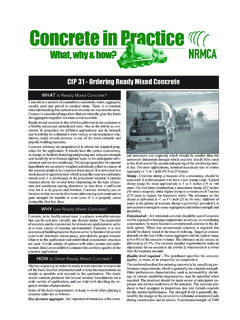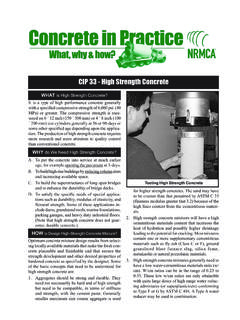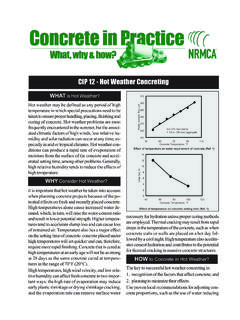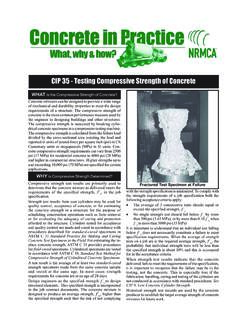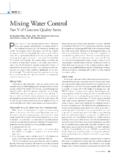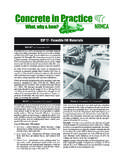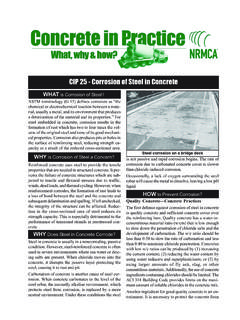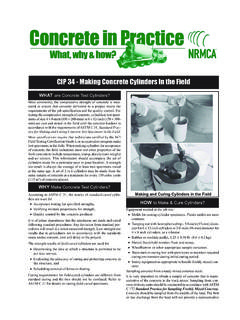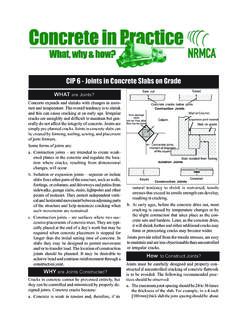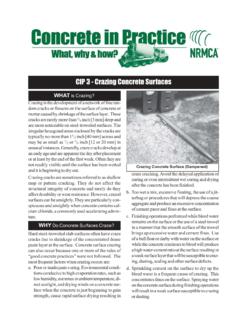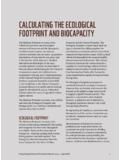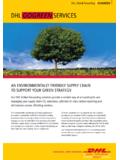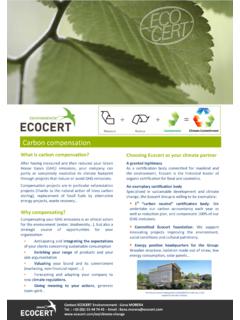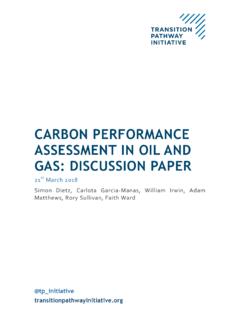Transcription of Concrete CO Fact Sheet - National Ready Mixed …
1 NRMCA Publication Number 2 PCO2 Concrete CO2 fact Sheet June 2008 Copyright 2008 by the National Ready Mixed Concrete Association All Rights Reserved Concrete CO2 fact Sheet JUNE 2008 2 Forward This publication was written by the National Ready Mixed Concrete Association to help its members understand the complexities of climate change and the greenhouse effect. NRMCA and its members are dedicated to continuous environmental improvement through product and process innovation. This publication provides a brief overview of the Concrete industry s role in minimizing environmental impact related to carbon dioxide emissions. Disclaimer This publication is intended for the use of professional personnel, competent to evaluate the significance and limitations of its content, and who will accept responsibility for the application of the material it contains. The National Ready Mixed Concrete Association and the other organizations cooperating in the preparation of this publication strive for accuracy but disclaim any and all responsibility for application of the stated principles or for the accuracy of the sources.
2 Unless otherwise indicated, all materials on these pages are copyrighted by the National Ready Mixed Concrete Association or cooperating organizations. All rights reserved. Therefore, reproduction, modification or retransmission, in any form is strictly prohibited without prior written permission from the National Ready Mixed Concrete Association. 2008 National Ready Mixed Concrete Association. Concrete CO2 fact Sheet JUNE 2008 3 Concrete CO2 fact Sheet Introduction Concrete is the most widely used building material in the world because of its beauty, strength and durability, among other benefits. Concrete is used in nearly every type of construction, including homes, buildings, roads, bridges, airports and subways, just to name a few. And in an era of increased attention on the environmental impact of construction, Concrete performs well when compared to other building materials. As with any building product, production of Concrete and its ingredients does require energy that in turn results in the generation of carbon dioxide, or CO2.
3 The amount of CO2 produced during manufacturing and the net impact of using Concrete as a building material is relatively small. The following features of Concrete construction help minimize its carbon footprint: Concrete is resource efficient and the ingredients require little processing. Most materials for Concrete are acquired and manufactured locally which minimizes transportation energy. Concrete building systems combine insulation with high thermal mass and low air infiltration to make homes and buildings more energy efficient. Concrete has a long service life for buildings and transportation infrastructure, thereby increasing the period between reconstruction, repair and maintenance and the associated environmental impact. Concrete , when used as pavement or exterior cladding, helps minimize the urban heat island effect thus reducing the energy required to heat and cool our homes and buildings.
4 Concrete incorporates recycled industrial byproducts such as fly ash, slag and silica fume which helps reduce embodied energy, carbon footprint and quantity of landfilled materials. Concrete absorbs CO2 throughout its lifetime through a process called carbonation, helping reduce its carbon footprint. The following facts help tell the story of Concrete and CO2. What is CO2? CO2 is the chemical formula for carbon dioxide, a gas which exists in relatively small amounts (380 parts per million or ppm) in our atmosphere. In general, it is exhaled by humans and animals and utilized by plants during photosynthesis. Additionally, carbon dioxide is created by the combustion of fossil fuels or plant matter, among other chemical processes. Carbon dioxide is one of several greenhouse gases that can cause global warming by trapping the Sun s radiant energy in our atmosphere. This process is called the greenhouse effect.
5 Greenhouse gases include water vapor (36-70%), carbon dioxide (9-26%), methane (4-9%) and ozone (3-7%), among others. The percentages indicate the approximate range of the Concrete CO2 fact Sheet JUNE 2008 4 greenhouse effect resulting from these greenhouse gases. Water vapor, the most abundant greenhouse gas, is not affected by human Atmospheric concentrations of CO2 are expressed in units of parts per million by volume (ppm). Since the beginning of the Industrial Revolution in the late 1700s, the concentration of CO2 in our atmosphere has increased by about 100 ppm (from 280 ppm to 380 ppm). The first 50 ppm increase took place in about 200 years, from the start of the Industrial Revolution to around 1973; the next 50 ppm increase took place in about 33 years, from 1973 to 2006. It is estimated that 14% of the CO2 in the atmosphere is due to burning fossil fuels. It is also estimated that 64% of the CO2 added to the atmosphere since 1850 is due to burning fossil Figure 1 - CO2 Concentrations in Earth's atmosphere during the last 400,000 What is global warming?
6 Global warming is the increase in the average temperature of the Earth's atmosphere and oceans as a result of the buildup of greenhouse gases in our atmosphere. Global warming is sometimes called climate change. Greenhouse gases can either be released by natural events such as volcanic eruptions or human activity such as deforestation or burning fossil fuels to manufacture products, power our cars and trucks, or to create the energy to heat and cool the homes we live in and the buildings we work in. Livestock, agriculture, landfill emissions and use of chlorofluorocarbons in refrigeration systems are other sources of greenhouse gases resulting from human activity . Many scientists believe global warming will cause a rise in sea level, increase the intensity of extreme weather, and change the amount and pattern of precipitation. Other effects could include changes in agricultural yields, glacier retreat, species extinctions and increases in disease.
7 These effects could severely impact the Earth s ability to support life. Concrete CO2 fact Sheet JUNE 2008 5 Many scientists believe recently observed global warming is partially caused by greenhouse gas emissions from energy production, transportation, industry and agriculture. Figure 2 - Variation of global What s the difference between cement and Concrete ? The terms cement and Concrete are often used interchangeably. Cement is an ingredient of Concrete . It's the fine, gray powder that, when Mixed with water, sand and gravel, forms the rock-like mass known as Concrete . Cement acts as the binding agent or glue. Cement is produced by cement manufacturers around the world in cement plants. The product from the burning process during manufacture of cement, called clinker, is then interground with other ingredients to produce the final cement product. Concrete is the rock-like product that is used to build our homes, buildings, roads, bridges, airports and subways, among other critical structures.
8 Concrete is used in almost every form of construction. It s made by Concrete producers who combine materials, including cement, water, sand and gravel, along with other chemicals and minerals to create Concrete . Does cement manufacturing generate CO2? As with all industrial processes requiring energy, manufacturing cement does result in the generation of CO2. Cement is manufactured from a combination of naturally occurring minerals - calcium (60% by weight) mainly from limestone or calcium carbonate, silicon (20%), aluminum (10%), iron (10%) and small amounts of other ingredients and heated in a large kiln to over 1500 C (2700 F) to convert the raw materials into clinker. For the most part, CO2 is generated from two different sources during the cement manufacturing process: Concrete CO2 fact Sheet JUNE 2008 6 Use of fossil fuels in the burning process; Calcination, when calcium carbonate is heated and broken down to calcium oxide with the release of CO2.
9 The most commonly used cement is called portland cement. It contains about 92% to 95% clinker by weight. Some companies produce blended cements that incorporate other industrial byproducts that have cementitious properties, thus reducing the amount of clinker in the cement. Other parts of the manufacturing process such as operating mining equipment for extracting the raw materials and transportation of the raw materials to the cement plant emit relatively small amounts of CO2. According to the Department of Energy, cement production accounts for of energy consumption in the The current level is low compared with other industries, such as petroleum refining at , steel production at and wood production at According to EPA, between 900 and 1100 kg (1984 and 2425 lbs) of CO2 is emitted for every 1000 kg (2205 lbs) of portland cement produced in the This depends on the fuel type, raw ingredients used and the energy efficiency of the cement According to the most recent survey of Portland Cement Association (PCA) members, an average of 927 kg (2044 lb) of CO2 are emitted for every 1000 kg (2205 lb) of portland cement produced in the Between 50% and 60% of the CO2 emitted is a result of calcination of calcium carbonate raw materials, a necessary part of the manufacturing process.
10 The remaining CO2 emitted is a result of burning fossil fuels such as coal and natural gas to heat the raw materials in the kiln. The cement industry accounts for approximately of CO2 emissions, well below other sources such as heating and cooling our homes (21%), heating and cooling our buildings (18%), driving our cars and trucks (33%) and industrial operations (28%).8 2005 CO2 EmissionsTransportation 33%Commercial 18%Residential21%Industry28% Figure 4 2005 CO2 emissions by category. Concrete CO2 fact Sheet JUNE 2008 7 Global CO2 emissions from cement production (298 million metric tons of carbon in 2004) represent of global CO2 releases from fossil-fuel burning and cement Global emission contributions from cement production are likely to decrease as countries like China replace inefficient kilns. The cement industry has made considerable strides to improve its energy efficiency and reduce emissions.
